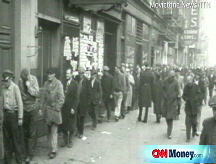Credit strained by skittish lenders
Economic weakness and turmoil in the banking sector keep lenders on the defensive despite easing lending rates.
NEW YORK (CNNMoney.com) -- Credit markets remain under pressure as the weak economy and ongoing turmoil in the banking sector continue to take a toll on lending confidence.
While lending rates have come down since the credit market seized up after Lehman Brothers' collapse in September, banks continue to be concerned about the credit quality of many borrowers as the recession drags on.
Rising unemployment has made many consumer loans untenable and weak corporate results raise questions about lending to businesses.
But the key to restoring confidence in the credit market lies with the illiquid securities festering on the balance sheets of many major banks, said Dr. Quincy Krosby, chief investment strategist at The Hartford.
"The market is waiting for the financials to stabilize," Krosby said. "It's very clear that the toxic assets will have to be dealt with one way or another."
Those assets, which are tied to mortgages and have tumbled in value as the housing market declined, resulted in huge losses for banks and caused major volatility in the stock market.
One solution being discussed in Washington is to create a so-called "bad bank" that would buy the assets and hold them until the economy and the housing market recover.
Another plan involves the government guaranteeing some of the losses that banks would have to take on the bad assets. But placing a value on the assets is difficult, and it remains unclear how much liability the government is willing to assume.
In either case, the government's role in the private sector will be expanded.
"The government is going to have to make some difficult decisions as to which banks will be kept alive," Krosby said.
Indeed, the government has dramatically expanded its influence in the banking sector through the Treasury Department's Troubled Asset Relief Program, or TARP.
Last week, Bank of America (BAC, Fortune 500) received $20 billion in TARP funds to ease its digestion of recently acquired Merrill Lynch. That came after Citigroup (C, Fortune 500) got a $20 billion bailout from TARP in November.
Altogether, the government has spent nearly $200 billion on bank recapitalization.
To fund its myriad of bailout and economic stimulus plans, the government has issued billions of dollars in debt over the last few months. This week alone, the Treasury auctioned almost $120 billion worth of debt.
Meanwhile, President Barack Obama has proposed additional stimulus measures that are currently being debated in Congress.
Congressional Democrats have advocated tax cuts and infrastructure spending that they say will create millions of jobs. But some Republican lawmakers oppose additional spending given the nation's budget deficit, which is projected to top $1 trillion this year.
Still, most economists agree that something needs to be done to stimulate the economy.
"At this stage of the cycle you want a government that's there, priming the pump," Krosby said. "When the economy starts growing again, then the government will cut deficit."
Lending rates: Lending rates edged higher Friday, signaling the ongoing strain in the credit markets.
The 3-month Libor rate increased to 1.17% from 1.16% Thursday, according to data available from Bloomberg.com. The overnight Libor rose to 0.24% from 0.21%.
Libor, the London Interbank Offered Rate, is a daily average of rates 16 different banks charge each other to lend money in London, and it is used to calculate adjustable-rate mortgages. More than $350 billion in assets are tied to Libor.
Two credit market gauges also showed showed signs of less confidence in the credit markets.
The so-called "TED" spread, a measure of banks' willingness to lend, widened to 1.07 percentage points from 1.04 percentage points Wednesday. The bigger the TED spread, the less willing investors are to take risks.
The rate surged as the credit crisis gripped the economy, but has since fallen off as central banks around the world have lowered interest rates and pumped the economy with liquidity.
Another market indicator, the Libor-OIS spread, was unchanged at 0.92 percentage points. The Libor-OIS spread measures how much cash is available for lending between banks, and is used for determining lending rates. The bigger the spread, the less cash is available for lending.
Treasurys: Prices for U.S. government debt continued to fall Friday. Treasurys have been declining partly due to a record supply of debt used to fund stimulus programs hitting the market.
The 10-year benchmark Treasury note fell 3/32 to 109-25/32, and its yield was edged up to 2.61%. Bond prices and yields move in opposite directions.
The 30-year bond sunk 1-2/32 lower to 122-4/32, and its yield was 3.3%. Last week, the 30-year bond was trading above 132 and its yield was at 2.87% in midday trade.
The 2-year note rose less than 5/32 to 100-6/32, and its yield was 0.8%.
Meanwhile, the yield on the 3-month note fell to 0.10% from 0.12% Thursday. The 3-month bill has been used as a gauge of confidence in the marketplace because investors tend to shuffle funds in and out of the bill as they asses risk in other places. ![]()




